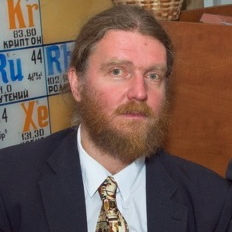Kola Alkaline Province: Ores, Rocks and Minerals—In Memory of Dr. Gregory Yu. Ivanyuk
A special issue of Minerals (ISSN 2075-163X). This special issue belongs to the section "Mineral Deposits".
Deadline for manuscript submissions: closed (30 November 2019) | Viewed by 20997
Special Issue Editor
2. Department of Crystallography, Institute of Earth Sciences, St. Petersburg State University, University Emb. 7/9, 199034 St. Petersburg, Russia
Interests: mineralogy; crystallography; structural complexity; uranium
Special Issues, Collections and Topics in MDPI journals
Special Issue Information
Dear Colleagues,
The Kola Alkaline Province contains the world’s largest peralkaline and alkaline-ultrabasic massifs (Khibiny, Lovozero, Kovdor, Tury Mys, etc.), with giant deposits of strategic and critical metals, including Fe, Ti, Nb, Ta, Zr, Al, Na, K, Sc, REE, and P. Aspects of their genesis include plumes, magmatic reservoirs, magmatic and post-magmatic differentiation, geochemistry of incompatible elements, subsolidus events, plication and fault tectonics, accumulation and emission of hydrogen and hydrocarbon gases, etс. In addition, the Kola Alkaline Province is the world’s largest source of new mineral species (above 300) and natural prototypes of important functional materials (ETS-4, AM-4, IE-911, SIV, etc.), which makes it a source of important information on the crystal chemistry and conditions of synthesis of new mineral-like compounds.
This Special Issue will cover a wide range of topics related to the problems of geology, tectonics, petrology, geochemistry, mineralogy, and crystal chemistry of the Kola alkaline complexes, as well as technological problems of deep ore processing.
This Special Issue is dedicated to Dr. Gregory Yu. Ivanyuk on the occasion of his unexpected passing.
Prof. Dr. Sergey V. Krivovichev
Guest Editor
Manuscript Submission Information
Manuscripts should be submitted online at www.mdpi.com by registering and logging in to this website. Once you are registered, click here to go to the submission form. Manuscripts can be submitted until the deadline. All submissions that pass pre-check are peer-reviewed. Accepted papers will be published continuously in the journal (as soon as accepted) and will be listed together on the special issue website. Research articles, review articles as well as short communications are invited. For planned papers, a title and short abstract (about 100 words) can be sent to the Editorial Office for announcement on this website.
Submitted manuscripts should not have been published previously, nor be under consideration for publication elsewhere (except conference proceedings papers). All manuscripts are thoroughly refereed through a single-blind peer-review process. A guide for authors and other relevant information for submission of manuscripts is available on the Instructions for Authors page. Minerals is an international peer-reviewed open access monthly journal published by MDPI.
Please visit the Instructions for Authors page before submitting a manuscript. The Article Processing Charge (APC) for publication in this open access journal is 2400 CHF (Swiss Francs). Submitted papers should be well formatted and use good English. Authors may use MDPI's English editing service prior to publication or during author revisions.
Keywords
- Kola Alkaline Province
- Peralkaline massifs
- Phoscorite-carbonatite complexes
- Petrology
- Geochemistry
- Mineralogy
- Crystal chemistry
- Giant mineral deposits





